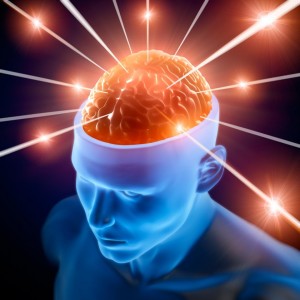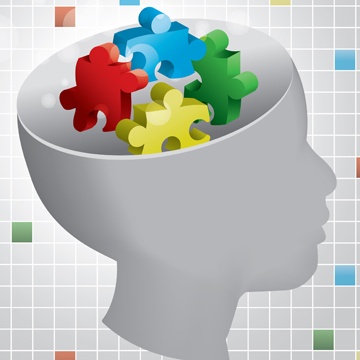Class < How to Teach Children with Autism < Lesson One - Autism - What is it?
Autism - What is it?
I'm going to firstly give you my definition for autism which you won't find in any text book, however I am convinced the future of autism is evolving and on the verge of huge positive and potentializing change. I came up with my definition after many years of working and observing kids who have autism; from talking and interviewing parents; from researching, studying and reading on the subject; and trialing my methods and seeing results.
I personally believe autism is a difference in the way the brain is wired which means that the individual who has autism views, experiences, orientates and negotiates their world, environment and life in an extremely different way to what is considered the 'norm'. Autism is where sensory experiences are heightened and illuminated, so all the senses are acute and oftentimes overwhelming.

Individuals with autism tend to 'learn' differently and uniquely and this is varied for every person. Additionally many experience the world with a myriad and variety of sensory 'problems' (a subject we will discuss in depth later in this course), and I personally believe sensory issues are a big reason behind many of the 'behavior' problems that we see in children on the Autism Spectrum; especially meltdowns, tantrums, anxiety and other debilitating conditions.
People with autism think in systems, so what that means is that they have to put all parts of something together for it to make sense. For example, a person may not immediately see a 'table', but will notice the legs of the table, the top of the table, the color, and then they have to put everything together to work out that all of those 'systems' put together make a 'table'.
Sometimes they don't know where one item begins and another ends. For example, they may view objects on top of the table as part of the table.
Also students who have autism have what is called 'face blindness', so they have trouble putting all of the parts of the face together such as the eyes, nose, mouth, cheeks, the overall shape of a face. What this means for them is 1. They have trouble looking at the face because it is hard for them to focus and 2. They are unable to recognize one face from another. (This is why you should NEVER force a child with autism to look you in the eyes because this is literally a painful, confusing and disorienting experience for them. Once you've built up trust, you can ask them to look at you and then give them about ten seconds to do so. If they still refuse, please don't force them).
All of this put together signifies an extremely unique, interesting and capable human being; the problem is their capabilities are largely masked by being overloaded by sensory overload, anxiety and behaviors they can't control because of autism. However, what makes these individuals capable and unique can also be debilitating and disempowering. So as you can see pinpointing a finite definition is actually quite difficult. I found this video by a young man called Arman Khodaei. He has autism and has over 200 videos on his YouTube Channel explaining the various dynamics of autism. Please take a look at his video as he endeavors to explain what autism is. It is very interesting as he spends allot of time going through what it is already known, but it is his last comment that I like; that we need to be open minded about what autism is; and that everyone needs to come up with their own definition.
The one thing I know for certain is that there is more to autism that meets the eyes. Yes, it is a complex and confusing state of being and one that causes a lot of stress to parents and families, and by no means do I wish to demean or diminish the plight of these families. However, more and more kids are being diagnosed and we can't ignore this. There are many bodies and organizations out there researching, looking for causes and therefore cures; so this course is not going to address that side of this condition.
Traditional meaning and what does it mean for education?
What is Autism Spectrum? Definition adapted from Autism Victoria.
Autism Spectrum (AS) has an impact on an individual’s ability to communicate, socialize and think imaginatively. These figures are quite significant and the growing population of children with autism have huge implications for all health professionals, teachers and because at some point in time you will come face to face with this issue (if they haven’t already done so).
According to Autism Speaks autism spectrum disorder (ASD) and autism are both general terms for a group of complex disorders of brain development. These disorders are characterized, in varying degrees, by difficulties in social interaction, verbal and nonverbal communication and repetitive behaviors.
Since publication of the DSM-5 diagnostic manual in 2013 all autism disorders have been merged under one umbrella diagnosis of ASD. Previously, these were all grouped independently as autistic disorder, childhood disintegrative disorder, pervasive developmental disorder-not otherwise specified (PDD-NOS) and Asperger's syndrome. There is still a lot of controversy about the decision to put all of these so-called disorders into one 'box'.
ASD can also be associated with intellectual disability, difficulties in motor coordination and attention and physical health issues such as sleep and gastrointestinal disturbances.
Autism appears to have its roots in very early brain development and it is also believed the condition may have some genetic component. However, the most obvious signs of autism and symptoms of autism tend to emerge between 2 and 3 years of age.
Reuters (2014) in New York recently reported that about one in 68 children in the United States have autism or a related disorder, the highest estimate to date, which is a 30% increase since 2012. This is also backed up on the Autism Speaks' website.
There is increasing the debate on 1. What is causing the increase and whether there is a need for a cure and 2. How can governments and services provide better resources to assist parents and carers who have children diagnosed with autism.
According to Autism Speaks, one of the leading advocacy, funding and research organizations, we still are unsure of what causes autism, but we do know that there is no one cause of autism and also not one type of autism. Scientists over the last few years have identified some genetic identifiers linked to autism, but it is still believed that there are also environmental factors that may influence early brain development. We are still along way from really understanding autism and research on causes and cures can take a very long time, so I believe it is more imperative that we focus on services and how we can assist families and children affected by this condition.
It is the view of many researchers and experts such as Simon Baron-Cohen (2005) and Temple Grandin (2010) that autism is not so much a disorder but indeed a difference in learning styles or in the way the brain functions. Therefore rather than trying to find a way to ‘fix’ or ‘cure’ these children it is more important to understand them and cater to their differences.

Dr Simon Baron-Cohen's video below is an interesting discussion on genetic and cultural influences on autism.
Temple Grandin is clear that ‘understanding the specific learning style of each brain you meet helps you relate to and educate that particular brain’. In the video below Temple is interviewed on her view that the world needs all kinds of brains.
In the past eight years of working with students with autism I’ve discovered that understanding my student; how they think; how their brain works; and how they learn assists in being able to provide a 'big' picture of my student and their needs. My role as an educator and consultant is to go into schools and family’s homes and troubleshoot problems. During this time, I find I’m not just dealing with the child who has autism, but the entire family. I need to observe the child, the classroom, the family, the environment and other external factors; I need to identify diet, sleeping habits and routines; and then put it all together to come up with what the main issues are and then provide strategies to address them. This takes training, and knowledge, as well as having a very clear understanding of what autism is and how to connect to the child and the family. It also takes patience, commitment and a calm approach.
Autism is a very 'individual' condition
No two individuals who have autism are alike, so just because you know one child with autism, doesn't mean all children will have the same quirks and identifiers. This is an extremely individual ‘condition’.
(As a teacher I do not believe that autism is a disorder or disability hence why I have taken out the "Disorder" in Autism Spectrum… I will explain this further as we go on).
The term Autism Spectrum (AS) reflects the fact that no two people with an AS are alike, hence the word ‘spectrum’. This indicates that the condition is on a continuum with a varying range of identifiers, issues and parameters depending on where each child/person sits on the continuum. Even though individuals with AS have difficulties in the areas of communication, socialization, and imagination or flexibility of thought, each will be at a different point on the spectrum. Some people with an AS will be able to live independent lives while others may always need assistance and support. Many have unique talents and abilities that ‘autism’ masks and it is here where I believe anyone who works with clients with autism need to discover the potential in all people despite their autism.
Secondary conditions and difficulties associated with autism
Some people with AS have other conditions as well, such as speech and language difficulties, intellectual disabilities, sleep problems, attention problems, epilepsy, anxiety and depression, and difficulties with fine and gross motor skills. Many have auditory processing and sensory processing problems which makes communication and understanding requests extremely difficult. There are also other conditions that are associated with AS, including Fragile X Syndrome, Tuberous Sclerosis and other genetic disorders.
Many have difficulties interpreting sensory information, and may display over or under-sensitivity and this can be one of the major factors for ‘meltdowns’ and behavior issues. Being over-sensitive to sound, touch, taste, smell and vision can be very distressing to individuals with an AS and hence can result in very strong reactions and we will explore this further throughout this course.
Anxiety and emotional regulation
One of the defining diagnostic criteria is repetitive and restricted behaviors often thought to be related to anxiety or emotional irregularity. As a result repetitive questioning and obsessive involvement in special interests becomes more pronounced when a person is anxious. Studies have found elevated levels of anxiety in children with AS compared to typically developing peers (Chalfant, Rapee & Carroll, 2006).
I also think that extreme anxiety can occur as a result of sensory issues; a disruption in routines; and generally an inability to cope with what is expected of them. Throughout this course we will be looking at all of these issues and you will develop strategies and skills to cater to these issues. The most important factor however is identification of what is causing the problem, hence why awareness of autism and its various intricacies is essential for anyone who is going to work in this field.
Sensory-cognitive processing
(Adapted from The World of Autism)
Although there were early signs that sensory integration was a problem in individuals with autism; research did not develop until autobiographical accounts such as those by Temple Grandin and Donna Williams began to appear in which sensory processing was highlighted. Childhood recollections describe visual distortions, tactile defensiveness and sound sensitivity. This has been complemented by parental accounts that sensory issues seem to be aligned with an autism diagnosis. Confirming the evidence from first hand accounts and infancy studies, recent survey investigations have found a significantly higher incidence of sensory sensitivities among the children with ASDs than age-peers (Keane, 2004).
A considerable body of research has emerged indicating that individuals on the AS have uneven patterns of brain development, with strengths in rote memory and/or visual processing and in some cases, savant skills. Studies have also found ‘executive dysfunction’ in AS (Ozonoff, South & Provencal, 2005). Children with autism tend to have an atypical learning style that reflects higher order thinking, inflexibility, novel and unusual ideas, exceptional memory and generally seeing their world in systems (we'll discuss this later). In my work with children with autism, I have found that sensory issues are a huge part of the behavioral issues that the children experience and the trick is deciphering what is affecting these kids on a sensory level. In fact it was this epiphany that sent me on my search to find out more. I was teaching at a 'special' school and our Junior School were in the main hall for a singing music session. I noticed that almost all the AS students were writhing in pain, hands over their ears, crying during these sessions. This was not just a one off, but week after week I watched this poor kids in an extremely uncomfortable state. I began to wonder what were we putting these kids through? Finally, I sought to have these children removed from these sessions and replace the session with a more calm, meditative session instead. The difference was remarkable, not just during this session but throughout the week as well. These kids generally calmed down and I was propelled to research more. I now believe understanding sensory issues are tantamount to understanding the behavior issues of children who are on the AS. Sensory issues will be explored further in Lessons Five and Six.
Donna Williams explains sensory issues and anxiety in the following video. Donna has autism, so I think this is extremely valuable insight into how it feels for children who have autism.
© Karina Barley 2014

